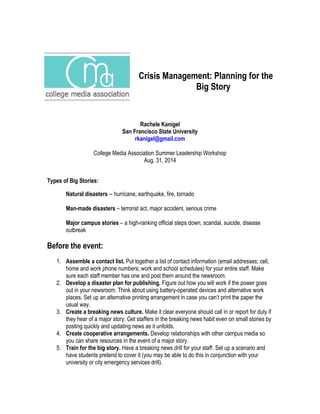
Preparing for the big story
- 1. Crisis Management: Planning for the Big Story Rachele Kanigel San Francisco State University rkanigel@gmail.com College Media Association Summer Leadership Workshop Aug. 31, 2014 Types of Big Stories: Natural disasters -- hurricane, earthquake, fire, tornado Man-made disasters – terrorist act, major accident, serious crime Major campus stories – a high-ranking official steps down, scandal, suicide, disease outbreak Before the event: 1. Assemble a contact list. Put together a list of contact information (email addresses; cell, home and work phone numbers; work and school schedules) for your entire staff. Make sure each staff member has one and post them around the newsroom. 2. Develop a disaster plan for publishing. Figure out how you will work if the power goes out in your newsroom. Think about using battery-operated devices and alternative work places. Set up an alternative printing arrangement in case you can’t print the paper the usual way. 3. Create a breaking news culture. Make it clear everyone should call in or report for duty if they hear of a major story. Get staffers in the breaking news habit even on small stories by posting quickly and updating news as it unfolds. 4. Create cooperative arrangements. Develop relationships with other campus media so you can share resources in the event of a major story. 5. Train for the big story. Have a breaking news drill for your staff. Set up a scenario and have students pretend to cover it (you may be able to do this in conjunction with your university or city emergency services drill).
- 2. 6. Know and develop the strengths of your staff. Make sure you have some writers who can write really fast, that reporters know how to look up public documents at a moment’s notice, that designers can create infographics quickly, that online producers can post stories and photos from anywhere. 7. Practice using tools you may want to employ later (liveblogging, livestreaming video, document searches, crowdsourcing, etc.) As the news breaks: 8. Report what you know ASAP. Don’t feel you have to wait to get the full story. Report the basic facts via Twitter, news alerts, mobile alerts and Facebook. That sends the message to readers that you’re on the story and they should come back to you for updates. 9. Assemble a team. Assign reporters, photographers, editors, graphic artists, online producers and designers to work on the story. Break the story into manageable assignments and make sure each team member understands his or her role so people aren’t duplicating efforts. 10. Staff your newsroom. Keep a few key people in the newsroom to take phone calls and assign stories and photos as new developments arise. 11. Assign a rewrite person. Designate one or two of your best – and fastest – writers to put together the major story as reporters in the field call in information or send dispatches. 12. Plan a package. Don’t try to tell the story in one big article. Think about sidebars, lists, infographics, bios of key players, timelines, info boxes and other devices to make the story engaging and thorough. 13. Check social media frequently. Use Twitter, Facebook, Instagram and other social media channels as a reporting tool for gathering information and collecting sources. But remember that information posted on social media is often wrong. Try to confirm all information with live or credible sources. 14. Think visually. Look for graphic elements that will help tell the story – timelines, explanatory graphics, info boxes. 15. Develop a logo or project title. Think about a catchy title that you can use for the breaking news package and follow-up stories. If you have time, create a logo to go along with it. 16. Keep your readers in mind. Think about what readers will want and need to know – names of people injured or killed, shelters and other services for people affected, places to donate money, food or clothing. 17. Use multimedia storytelling online. Use audio, video, slide shows or photo galleries, and other multimedia devices to tell the story on your website. 18. Employ maps -- in print and online. Help readers visualize where things happened. 19. Think mobile. Keep in mind that readers may not have access to computers; prepare material for mobile devices. 20. Serve your readers. Think about the problems this story has presented to your community and consider how your news outlet can address them.
- 3. Following up: 21. Assess your coverage. Have a staff discussion evaluating what went well and what didn’t. Learn from your mistakes. 22. Brainstorm. Have the staff develop ideas for follow-up stories and new angles. 23. Editorialize. Use your editorial page to reflect on the big story. How did campus officials, local, state and/or national officials handle the crisis? What went wrong? What went right? 24. Make space for letters. If you get a large number of letters to the editor, create extra space for them or post a letters section on your website. Let your readers know you’re listening to them. 25. Ask why. If a deadly fire breaks out, examine fire inspection reports. If a winning coach resigns unexpectedly, look at the factors that drove him or her to leave. Look at university policies, local and state laws and other factors that may have contributed to the crisis. 26. Take care of yourselves. If staff members are upset or traumatized by the event, get help from your campus counseling center. You may want to bring in a counselor to address your staff. 27. Don’t drop the ball. Most big stories demand follow up. Keep on the story until it’s really over. Follow up on lawsuits, reports, indictments and other news that may come weeks, months or even years after the news event.
